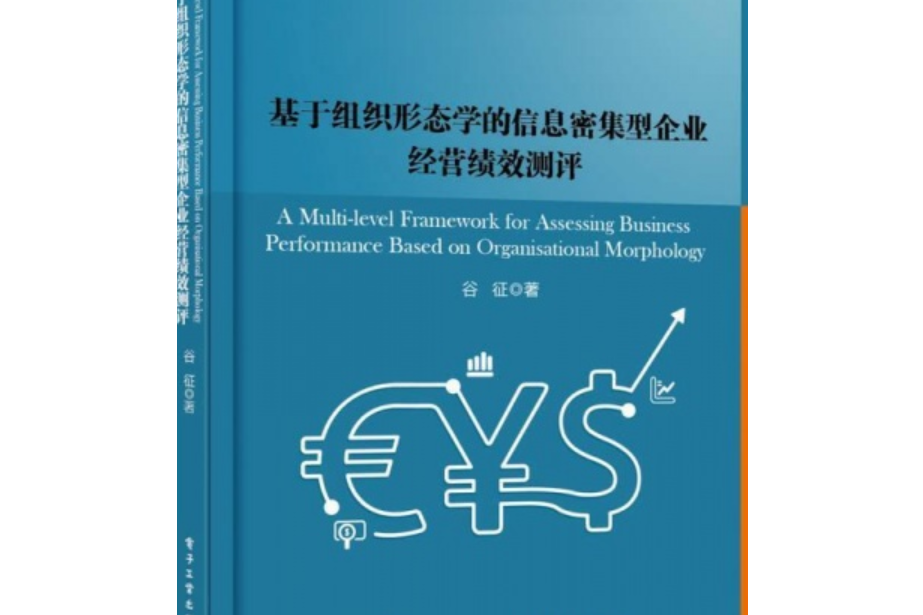《基於組織形態學的信息密集型企業績效測評》是2015年12月電子工業出版社出版的書籍,作者是谷征。
基本介紹
- 中文名:基於組織形態學的信息密集型企業績效測評
- 作者:谷征
- 出版社: 電子工業出版社
- 出版時間:2015年12月
- 頁數:328 頁
- 定價:69 元
- 開本:16 開
- ISBN:9787121277788
內容簡介,作者簡介,目錄信息,
內容簡介
本書從組織形態學角度出發,建立MoBorea模型,用於分析企業中以信息為基礎的組織行為,進而在企業運營過程中對經營績效進行測評。本書闡述了組織形態學的相關背景,回顧了該領域國內外現有研究進展,系統分析了組織形態學的適用性,闡述了研究中數據收集和分析的方法,並提出了MoBorea模型以測評其企業運營績效。本書案例豐富、闡述清晰,可作為管理學、經濟學相關領域高年級本科生、研究生或相關研究人員以及從業人員的參考書。
作者簡介
谷征,1983年出生,北京人。2010年至今在中國農業大學經濟管理學院工作,任MBA教育中心常務副主任。獲中國農業大學管理學博士學位、英國雷丁大學哲學(管理學方向)博士學位,研究領域為組織績效評估、農業支持政策。至今共公開發表論文14篇,出版圖書3部。
目錄信息
Chapter 1 Introduction 1
1.1 Research Focus 4
1.2 Research Domain 5
1.3 Research Problems 7
1.4 Research Questions 10
1.5 Aim and Objectives 10
1.6 Methodology 12
1.7 Thesis Structure 13
1.8 Summary 14
Chapter 2 Literature Review 16
2.1 The Definition of Information Intensive Organisation 17
2.2 Approaches to Modelling information based Activities in IIOs 19
2.2.1 The Input-process-output Model 19
2.2.2 Process Modelling Methods 23
2.2.3 Functional Modelling Methods 27
2.3 Business Performance Measurement for Marketing 31
2.3.1 Traditional Framework for Marketing Measurement 32
2.3.2 Customer Satisfaction 36
2.3.3 Activity-based Performance Measurement 36
2.3.4 The Performance Measurement Matrix 38
2.3.5 SMART Pyramid 38
2.3.6 The Results-determinants Framework 40
2.3.7 Brown’s Input-process-output-outcome Framework 41
2.3.8 Balanced Scorecard 44
2.3.9 Comparison of Approaches 45
2.4 Organisational Morphology 49
2.4.1 Semiotics 49
2.4.2 Organisational Semiotics 51
2.4.3 Norm Based Activities 52
2.4.4 The Health of an Organisation 53
2.5 Summary 60
Chapter 3 Methodology 62
3.1 Types of Research Paradigms 63
3.2 Design Science 65
3.2.1 Guidelines for Design Science 66
3.2.2 General Research Steps for Design Science 72
3.3 Approach for This Study 73
3.3.1 Awareness of Problem 74
3.3.2 Suggestion 75
3.3.3 Development 75
3.3.4 Evaluation 76
3.3.5 Conclusion 77
3.4 Data Collection 78
3.4.1 Methods 78
3.4.2 Target Groups 79
3.4.3 Time and Duration 79
3.4.4 Methods for Data Analysis 80
3.5 Summary 80
Chapter 4 Multi-level Framework for Business Performance Measurement 83
4.1 Overview of Multi-level Framework 86
4.2 Domain Modelling Based on the Proposed Framework 88
4.3 Level 1: IPO Model 89
4.4 Level 2: DFD Method 90
4.4.1 Elements of DFD 91
4.4.2 Steps for DFD Method Modelling 92
4.4.3 Case Study of CCU MBA Centre 93
4.5 Level 3: Organisational Morphology Model 100
4.5.1 Organisational Morphology Analysis Table 100
4.5.2 The Morphology Element Mapping 105
4.5.3 The Informational Activity Effectiveness Chart 112
4.6 Summary 115
Chapter 5 Application of Morphology Based Organisational Effectiveness Assessment 117
5.1 Data Collection 118
5.1.1 Methods for Data Collection 119
5.1.2 Data Statistics 122
5.1.3 Data Analysis 124
5.2 MoBorea for CCU MBA 125
5.2.1 Performance Assessment for the First Round 126
5.2.2 Performance Assessment for the Second Round 137
5.2.3 Results Comparison between Two Rounds 147
5.3 Summary 152
Chapter 6 Evaluation of MoBorea 154
6.1 Evaluation Models 155
6.1.1 Group 1: Indicators in Marketing Activities 157
6.1.2 Group 2: Intermediate outcomes 166
6.1.3 Group 3: Final outcomes 167
6.1.4 Group 4: Marketing assets 168
6.1.5 Indicators for Evaluation Model 169
6.2 Data Collection 172
6.2.1 Data for Evaluation Model – First Round 173
6.2.2 Data for Evaluation Model - Second Round 173
6.3 Analysis of Evaluation Model Results 176
6.3.1 Data Analysis for Evaluation Model – First Round 176
6.3.2 Data Analysis for Evaluation Model – Second Round 180
6.3.3 Overall Marketing Performance Comparison of the Two Seasons 183
6.4 Comparison to MoBorea 185
6.4.1 Results Comparison of Two Approaches based on Weekly Data - First Round 185
6.4.2 Results Comparison of Two Approaches based on Weekly data – Second Round 186
6.4.3 Results Comparison of Two Approaches Based on Season Time-span 187
6.4.4 Conclusion for the Validation of MoBorea 188
6.5 The Benefits of MoBorea Compared to the Evaluation Model 189
6.6 Summary 191
Chapter 7 Case Study: MSU Training Programme 193
7.1 Case Background 193
7.2 Steps for Analysis 195
7.3 IPO Model 197
7.4 DFD Method Modelling 198
7.5 OM Model 200
7.5.1 Data Collection 201
7.5.2 The Morphology Element Mapping Analysis 202
7.5.3 The Informational Activity Effectiveness Chart Analysis 206
7.5.4 Summary of Results for the MSU Training
Programme Case 210
7.6 Summary 211
Chapter 8 Evaluation of the Research 212
8.1 Achievement of Aim and Objectives 212
8.1.1 Evaluation by Aim 212
8.1.2 Evaluation by Objectives 213
8.2 Guidelines of Design Science 220
8.2.1 Design as an Artefact 220
8.2.2 Problem Relevance 221
8.2.3 Design Evaluation 222
8.2.4 Research Contributions 223
8.2.5 Research Rigour 223
8.2.6 Design as a Search Process 225
8.2.7 Communication of Research 226
8.3 Summary 227
Chapter 9 Conclusion and Outlook 228
9.1 Research Conclusion 228
9.2 Research Contributions 231
9.2.1 Theoretical Contribution 231
9.2.2 Methodological Contribution 232
9.2.3 Practical Contribution 233
9.3 Limitations of Research 233
9.3.1 Accuracy of Identification for Information-based Activities 233
9.3.2 Classification for Morphological Types of Activities 234
9.3.3 Weight of Each Information Based Activities in
Developing the OM Method 235
9.3.4 Limited Scope for Data Collection 235
9.3.5 The Scope of Application of the Framework 235
9.3.6 Iterative Validation by Different Methods 236
9.4 Future Research 236
9.5 Conclusion 237
References 240
Appendices 258
Appendix 1: Organisational Morphology Analysis Table 258
Appendix 2: Data Collection Form for MoBorea 263
Appendix 3: Statistics of Information Based Marketing Activities – Round 1 268
Appendix 4: Statistics of Information Based Marketing Activities – Round 2 281
Appendix 5: Questionnaires for Students’ Satisfaction 296
Appendix 6-1: Statistics for Students’ Satisfaction 298
Appendix 6-2: Statistics for Students’ Satisfaction [Cont.] 300
Appendix 7: Data Collection Form for MoBorea for MSU Training Programme 302
Appendix 8: Statistics of Data Collection for the MSU Training Programme 307

